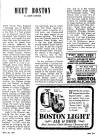
Home Page Meet Boston Menu Index
|
MEET BOSTON Friday, May 30, 1941 in What's New In Town W. J. Sidis |
The former New England Railroad, one of Boston’s most recent railroad lines, was a line that, if it had worked out as planned, would have developed New England and its ports, and made this port more than ever the most natural outlet for goods from the interior, especially for coal from the anthracite mine regions. This line connected Boston through Hartford with the middle Hudson Valley, where connections were made at Beacon and Poughkeepsie for the Pennsylvania coal district. Branches led to Worcester and Providence. Through trains from Boston to Hartford also ran to the tip of the Bronx peninsula, from where they were carried on boats to Jersey City and continued to points south and west. The New England line’s bridge at Poughkeepsie still remains the highest bridge over the Hudson. Its Boston approach was through Dorchester to a dock of gargantuan size in South Boston, branch tracks for passenger trains crossing a bridge over Fort Point Channel to a terminal at the foot of Summer Street. This station originally consisted of two connected wings, the south wing being for passengers, and the north wing for offices. About 1889, Summer Street was cut through to the Channel, separating the two wings; the north wing was then rebuilt as an office building, which still bears the name “New England.” In 1897, work was started on enlarging the depot, using the original station as a waiting room, uniting five terminals, one of which (the Fall River terminal), though nearly a quarter of a mile away, was incorporated into the same station as an express building. The bridge over the Channel became the Summer Street Bridge, and, in the two auto driveways outside modern South Station, it is easy to see the original terminal tracks with a platform between them. The present station is the largest in the country, next to New York’s Pennsylvania Station.
*
On the continent of North America there is just one natural east-and-west transcontinental route. The Mohawk Valley is the only convenient breach in the eastern mountain range (except the St. Lawrence River, heading much farther north); the only convenient pass through the Rockies is along the same line; and so is the narrow space between Great Lakes and Mississippi Valley. This natural trail, a main line of transcontinental communication, has been used by Indian runners, by covered wagons, by stage coaches, by railroads and by buses, with little alteration. Great cities, such as Albany, Rochester, Buffalo, Cleveland, Chicago, Omaha, and Salt Lake have grown up in its path. The western terminal is at San Francisco Bay; the east end of the trail is on the Mishawum peninsula (now Charlestown), and is approximately marked by City Square in that section of Boston.